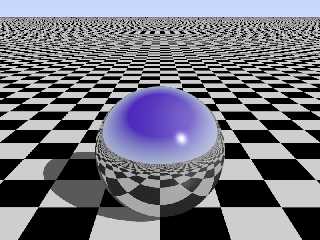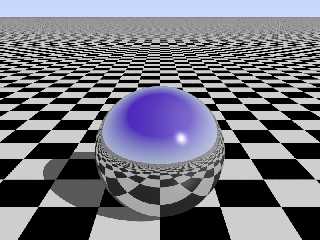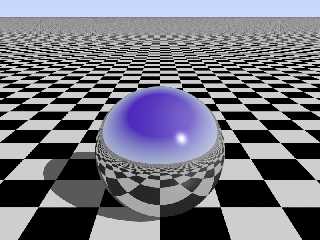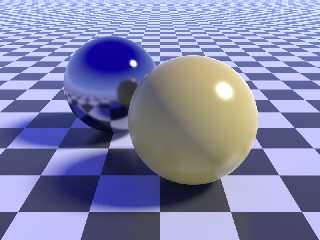 |
 |
|
 |
|
 |
|  |
|  |
|
 |
|
 |
|  |
|  |
|
 |
I guess I've posted an image showcasing this patch before, but now that
I'm actually preparing it for a release (not into POV-Ray proper, but an
unofficial branch I'm currently compiling from various fancy patches
that have accumulated in my drawer) and have finally tracked down a
serious performance issue, i thought I might post another set of
demonstration renders.
The first image was rendered with the standard anti-aliasing mode 2,
taking 6 seconds to compute. Note the moiree effects near the horizon,
which are resistent to any increase in anti-aliasing quality settings.
The second image was rendered with the new anti-aliasing mode, taking
only 5 seconds to compute. Note how the distant moiree is replaced by
random noise.
The third image demonstrates the increase in render quality that can be
achieved by cranking up the anti-aliasing quality settings. Moiree
patterns begin to show again, but they are less pronounced than with
anti-aliasing mode 2 (which, as I love to re-iterate, will not get any
better whatever you do). Render time was 84 seconds.
(Render times are comparatively long for such a simple scene because I
was using a debug version of the binary, with plenty of compiler
optimizations turned off.)
Post a reply to this message
Attachments:
Download 'am2.png' (193 KB)
Download 'am3.png' (256 KB)
Download 'am3+.png' (229 KB)
Preview of image 'am2.png'

Preview of image 'am3.png'

Preview of image 'am3+.png'

|
 |
|  |
|  |
|
 |
|
 |
|  |
|  |
|
 |
clipka <ano### [at] anonymous org> wrote:
> The first image was rendered with the standard anti-aliasing mode 2,
> taking 6 seconds to compute. Note the moiree effects near the horizon,
> which are resistent to any increase in anti-aliasing quality settings.
>
> The second image was rendered with the new anti-aliasing mode, taking
> only 5 seconds to compute. Note how the distant moiree is replaced by
> random noise.
In my experience, method 2 works better for most scenes, but method 1
(non-adaptive) wins hands down for checkered planes. I have achieved results
similar to your 2nd and 3rd images using method 1 with jitter (+AM1 +J). What
is the advantage of your new method over method 1? Is it adaptive like method
2? org> wrote:
> The first image was rendered with the standard anti-aliasing mode 2,
> taking 6 seconds to compute. Note the moiree effects near the horizon,
> which are resistent to any increase in anti-aliasing quality settings.
>
> The second image was rendered with the new anti-aliasing mode, taking
> only 5 seconds to compute. Note how the distant moiree is replaced by
> random noise.
In my experience, method 2 works better for most scenes, but method 1
(non-adaptive) wins hands down for checkered planes. I have achieved results
similar to your 2nd and 3rd images using method 1 with jitter (+AM1 +J). What
is the advantage of your new method over method 1? Is it adaptive like method
2?
Post a reply to this message
|
 |
|  |
|  |
|
 |
|
 |
|  |
|  |
|
 |
Am 23.07.2013 04:05, schrieb Cousin Ricky:
> In my experience, method 2 works better for most scenes, but method 1
> (non-adaptive) wins hands down for checkered planes. I have achieved results
> similar to your 2nd and 3rd images using method 1 with jitter (+AM1 +J). What
> is the advantage of your new method over method 1? Is it adaptive like method
> 2?
Yes, indeed; it uses an approach similar to the oversampling implemented
in focal blur (but takes neighboring pixels into account to do its
adaptive thing).
Method 1 with jitter does indeed do a comparatively good job; but its
quality settings don't always scale well, as the attached image
demonstrates - this was rendered with +am1 and extremely high-quality
settings (+a0.01 +r9). Fun fact: With a lower numbr of samples, the
artifacts in the distance didn't show.
More importantly however, in the branch I'm working on the new
anti-aliasing mode will serve as a key component to speed up renders
that combine multiple features that rely on some kind of oversampling,
like focal blur, area lights, media, SSLT and (coming later) blurred
reflections.
Post a reply to this message
Attachments:
Download 'am1.png' (198 KB)
Preview of image 'am1.png'

|
 |
|  |
|  |
|
 |
|
 |
|  |
|  |
|
 |
On Tue, 23 Jul 2013 06:58:45 +0200, clipka <ano### [at] anonymous org> wrote:
> blurred
> reflections.
>
=D
--
-Nekar Xenos- org> wrote:
> blurred
> reflections.
>
=D
--
-Nekar Xenos-
Post a reply to this message
|
 |
|  |
|  |
|
 |
|
 |
|  |
|  |
|
 |
Am 23.07.2013 21:51, schrieb Nekar Xenos:
> On Tue, 23 Jul 2013 06:58:45 +0200, clipka <ano### [at] anonymous org> wrote:
>
>> blurred
>> reflections.
>>
>
> =D
:-D org> wrote:
>
>> blurred
>> reflections.
>>
>
> =D
:-D
Post a reply to this message
Attachments:
Download 'stochastic_reflection_blur.png' (433 KB)
Preview of image 'stochastic_reflection_blur.png'

|
 |
|  |
|  |
|
 |
|
 |
|  |
|  |
|
 |
Looking forward to this. Formalist work is tough on AA.
"clipka" <ano### [at] anonymous org> wrote in message
news:51ee0d90@news.povray.org...
> Am 23.07.2013 04:05, schrieb Cousin Ricky:
> org> wrote in message
news:51ee0d90@news.povray.org...
> Am 23.07.2013 04:05, schrieb Cousin Ricky:
>
Post a reply to this message
|
 |
|  |
|  |
|
 |
|
 |
|  |
|  |
|
 |
On 23/07/2013 21:57, clipka wrote:
> Am 23.07.2013 21:51, schrieb Nekar Xenos:
>> On Tue, 23 Jul 2013 06:58:45 +0200, clipka <ano### [at] anonymous org>
>> wrote:
>>
>>> blurred
>>> reflections.
>>>
>>
>> =D
>
> :-D
You tease! org>
>> wrote:
>>
>>> blurred
>>> reflections.
>>>
>>
>> =D
>
> :-D
You tease!
Post a reply to this message
|
 |
|  |
|  |
|
 |
|
 |
|  |
|  |
|
 |
clipka <ano### [at] anonymous org> wrote:
> Am 23.07.2013 04:05, schrieb Cousin Ricky:
>
> > In my experience, method 2 works better for most scenes, but method 1
> > (non-adaptive) wins hands down for checkered planes. I have achieved results
> > similar to your 2nd and 3rd images using method 1 with jitter (+AM1 +J). What
> > is the advantage of your new method over method 1? Is it adaptive like method
> > 2?
>
> Yes, indeed; it uses an approach similar to the oversampling implemented
> in focal blur (but takes neighboring pixels into account to do its
> adaptive thing).
>
> Method 1 with jitter does indeed do a comparatively good job; but its
> quality settings don't always scale well, as the attached image
> demonstrates - this was rendered with +am1 and extremely high-quality
> settings (+a0.01 +r9). Fun fact: With a lower numbr of samples, the
> artifacts in the distance didn't show.
>
> More importantly however, in the branch I'm working on the new
> anti-aliasing mode will serve as a key component to speed up renders
> that combine multiple features that rely on some kind of oversampling,
> like focal blur, area lights, media, SSLT and (coming later) blurred
> reflections.
Why a branch instead of a predefined version number that would wait this feature
to get counted, like 3.7.5?
Is this because you feel it has too many drawbacks to make it to trunk ever?
what kind of licence would this branch use? org> wrote:
> Am 23.07.2013 04:05, schrieb Cousin Ricky:
>
> > In my experience, method 2 works better for most scenes, but method 1
> > (non-adaptive) wins hands down for checkered planes. I have achieved results
> > similar to your 2nd and 3rd images using method 1 with jitter (+AM1 +J). What
> > is the advantage of your new method over method 1? Is it adaptive like method
> > 2?
>
> Yes, indeed; it uses an approach similar to the oversampling implemented
> in focal blur (but takes neighboring pixels into account to do its
> adaptive thing).
>
> Method 1 with jitter does indeed do a comparatively good job; but its
> quality settings don't always scale well, as the attached image
> demonstrates - this was rendered with +am1 and extremely high-quality
> settings (+a0.01 +r9). Fun fact: With a lower numbr of samples, the
> artifacts in the distance didn't show.
>
> More importantly however, in the branch I'm working on the new
> anti-aliasing mode will serve as a key component to speed up renders
> that combine multiple features that rely on some kind of oversampling,
> like focal blur, area lights, media, SSLT and (coming later) blurred
> reflections.
Why a branch instead of a predefined version number that would wait this feature
to get counted, like 3.7.5?
Is this because you feel it has too many drawbacks to make it to trunk ever?
what kind of licence would this branch use?
Post a reply to this message
|
 |
|  |
|  |
|
 |
|
 |
|  |
|  |
|
 |
Am 24.07.2013 11:50, schrieb Mr:
>> More importantly however, in the branch I'm working on the new
>> anti-aliasing mode will serve as a key component to speed up renders
>> that combine multiple features that rely on some kind of oversampling,
>> like focal blur, area lights, media, SSLT and (coming later) blurred
>> reflections.
>
> Why a branch instead of a predefined version number that would wait this feature
> to get counted, like 3.7.5?
>
> Is this because you feel it has too many drawbacks to make it to trunk ever?
There are plenty of reasons for this.
First, I guess that users would rather test-drive these patches than
just being teased with test scenes - and as a matter of fact I myself am
itching to see the community test-drive it and provide feedback.
Second, the approach is quite different to what POV-Ray is doing now,
and will need thorough community testing before even deciding whether it
is worth including in POV-Ray proper.
Third, in the past POV-Ray has seen quite a bunch of patches, so we
should expect POV-Ray 3.7 to be patched as well, and I think it would be
good to establish some standards, best practices and easy-to-use
building blocks for patches and patch collections; a good tool to this
end would be some "prototype branch". I intend the branch I'm working on
to double-feature for this exact purpose, both in the sense of begin a
testbed for establishing those standards, best practices and building
blocks in the first place, as well as serving as a reference for future
branches.
> what kind of licence would this branch use?
It will be published under the Affero GNU General Puplic License (AGPL),
a variation of the GPL.
Post a reply to this message
|
 |
|  |
|  |
|
 |
|
 |
|  |
|
 |




![]()